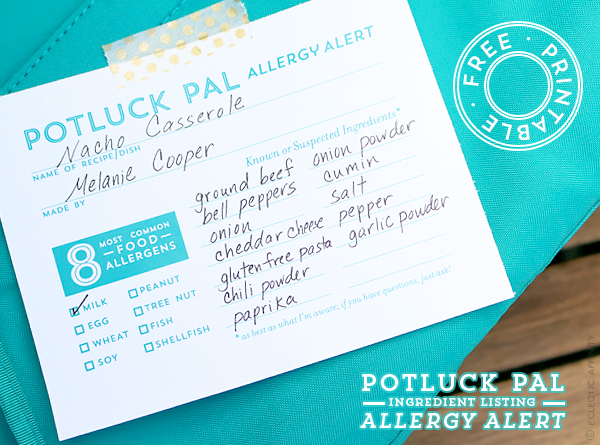The incidence of food allergies, intolerances, and sensitivities is climbing, which is why you’d be hard pressed to find someone who didn’t at the very least know someone with a food allergy, intolerance, or sensitivity even if not personally dealing with one. Some attribute this to our changing food supply, others to food-based additives contained within common medicines, and others to our modern, biologically changing gut microbe. Regardless of the reason, the possibility of food-related reactions makes the basics of eating together—an age-old custom of building community together—a sticky scenario. First, understand that food is more complex than singular ingredients. Salad dressing, for instance, isn’t a single ingredient—it’s whatever makes up the salad dressing, including the complex ingredients used within the listed ingredients. That means your “Simple Spring Salad” might not be so simple. Transparency is key, especially for those with severe food allergies, because it does a lot toward prevention. If someone reacts to something you’ve made, it’s no time to be shy about the ingredients. Their health and safety requires knowing whether this is a new allergen or a known one.
Eight foods (milk, egg, wheat, soy, peanut, tree nut, fish, shellfish) are the most common food culprits in a food allergy, but allergens can also include corn, meat, gelatin, seeds, spices, various medications, latex, insect stings, and more. That’s not even getting into reactions to things like food dyes and chemical additives which can cause reactions ranging from behavioral issues to instances requiring medical intervention. It’s important to understand that this isn’t as simple as indigestion or a sugar rush. For some it’s a matter of avoiding inflammatory foods that cause physical pain, but for others it can include the extreme of anaphylactic shock requiring an emergency trip to the hospital. (Read more here for more on the science behind food allergies and food sensitivities; click here for ideas on why our grandparents didn’t have food allergies.) What’s more, the thing about food allergies is that for each time you have an encounter, each subsequent reaction after that holds the potential of escalating. In the same way that people are trained on how to react to heart attacks, people need to become trained in how to deal with what’s unfortunately the new normal. Seconds matter. For that reason, consider stocking an auto-injector as part of your office, church, school, or organization’s safety kit.
Converting “potlucks” to bring-your-own-meal picnics is one alternative to avoiding allergic reactions (particularly if an encounter with an offending food via someone putting the egg bake spoon in the lasagna dish could land you in the emergency room or worse), but another alternative step in the right direction might be as simple as posting an allergen card with ingredient listings that correspond to each food brought in. However, please understand that this ISN’T a replacement for exercising caution. “Gluten-free” doesn’t necessarily mean “wheat-free.” A person making a peanut-free recipe doesn’t exclude that someone could have eaten a peanut butter sandwich and contaminated the dish. Cross-reactive ingredients aren’t something people without food allergies might take into consideration because it’s not something with which they’re familiar.
{*NOTE: the ONLY way to avoid a food allergy reaction is to avoid an allergenic food ingredient, including but not limited to things those items might have come in contact. Your eating choices should follow your doctor’s recommendations. No food risk is worth your life!}
(Download our free printable at the end of this post!) This obviously doesn’t solve the whole scenario (stay on guard and also keep packing that epinepherine!), but it comes closer to creating an environment that’s at the very least mindful of what food allergies and intolerances mean to those dealing with them. An environment like that fosters people really reading food labels and understanding this isn’t some annoying, attention-getting stunt for those really dealing with this. If you’ve experienced how frightening a food allergy can be, it’s not something you shake off very easily. Frankly, you can’t afford to forget. For a great post on what families with food allergies wish you knew, read this mama’s appreciative and heartfelt story on how she keeps her little boy safe. You can read about another mama who shares her experience of being “that mom” to keep her kiddos feeling like themselves. There’s even a series of cartoons.
Risk factors for food allergies can include, but are not limited to, the following:
- family history
- cesarean birth
- “Leaky Gut”—intestinal lining that’s immature (due to young age) or damaged (due to poor diet or other factors)
- prescription drug use
- antibiotic use
- exposure to foods containing antibiotics and/or GMOs
Allergies can occur any time. Since no one ever expects a food allergy, it’s sometimes recommended that small children (particularly those with a family history of food allergies) are introduced to new foods within the supervision of a parent or guardian and that new foods be introduced well before naps or bedtime. Additionally, some suggest new foods should be given in accordance with baby’s biological readiness for foods and be spaced out at least 3-5 days (some say 5-7 days or even a couple weeks) of each other. Some suggest by waiting until the body has developed proper enzymes to manage various foods, children have a better chance of avoiding allergies as they grow (as well as into adulthood) by nurturing gene expression for optimal health through epigenetics. Others suggest early introduction is optimal, theorizing that it helps children develop a tolerance. Then other theories surround the idea that pesticide exposure is a potential culprit, citing the vulnerability of young children as well as the long-term exposure for the onset of adult food allergies. However, allergy causation and prevention is still largely unknown and the data continually evolving.
Years ago it was thought that there was one kind of cancer and that it was simply found in different locations of the body. Now it’s believed there are many different kinds of cancers and thus theoretically many different kinds of cures. For all any of us knows, allergies (and their causation or causations) could be that complex as well. If the changing views on saturated fat have taught us anything, it’s this: there’s a lot we don’t know.
For more resources on food allergies, intolerances, sensitivities, as well as managing them, and even possibly reversing them, check out the following:
F.A.R.E. (Food Allergy Research & Education)
The GAPS Diet by Dr. Natasha Campbell-McBride
Wellness Mama’s 30-Day Autoimmune Reset
Another allergy-friendly idea is The Teal Pumpkin Project.
Robyn O’Brien (view her inspiring 2011 TED talk here and her 2014 one below.)
[Note: downloaded files, designs, and all content are © copyright Charm Design Studio, LLC. For personal—not commercial—use only. Use without permission is strictly prohibited. By downloading, you agree to these terms. For more on our policies, click here.]
This printable is not meant to replace good judgement or the advice of a physician. Using this printable is at your own risk. If you have ideas on how this printable (or future/different allergy-friendly printables) could be better, leave a comment!
Download our “Potluck Pal Allergy Alert” here: PotluckPal-AllergyAllert-EclecticAffinity



Pingback: 100+ Free Printables for Home & Health (Calendars, Habit Trackers, Wall Art and more!) - Red and Honey